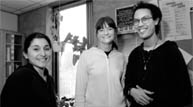Science and socializing

Co-organizers of the graduate student symposium: Lydia Bourouiba (atmospheric and oceanic sciences), Crystal Mann (earth and planetary sciences) and Ed Hudson (chemistry).
Owen Egan
Ever wonder how to identify a top quark event? Map the transition between avian and non-avian theropods? Me neither.
But I was probably in the minority at the third annual Interdisciplinary Graduate Student Research Symposium (IGSRS), held March 16 and 17 at McGill's New Residence Hall.
Research on these topics and many more was presented at this year's meeting, "Scientific Approaches to Complex Natural Systems." Drawing the largest and most diverse attendance to date, this year saw an appropriately mind-boggling scope of research from presenters in fields as disparate as environmental science, high-energy physics and the psychology of learning.
Organized by graduate students Lydia Bourouiba, Maria de Boef, Ed Hudson, Lila Dolansky, Crystal Mann, Elvis Pandzic and Nomair Naeemran, the IGSRS combined various scientific disciplines under a common theme — science within a social context. Divided into Nanoworld, Microworld and Macroworld, the conference saw 84 presenters — up from 66 in 2005.
"People tend to view scientists as working in isolation," says Hudson. "This event is a step towards changing that culture. If we are to address such pressing threats as global climate change, pandemic diseases or rampant inequality, we will need all kinds of thinkers communicating and working together."
Ten McGill departments were represented, as well as UQAM, Université de Montréal, Concordia University, Queen's, the University of Windsor and Michigan Tech.
Don Anderson, a noted geophysicist and philosopher of science at Caltech, delivered the keynote address, "Paradigms, Paradoxes and Poetry in Deep Earth Science," cautioning listeners on the perils of forgetting to question accepted paradigms and exhorting them to embrace paradox as a vital tool toward effective research.
While there were the traditional oral presentations, many researchers seized on the trend toward poster presentations. Increasingly popular at events like the IGSRS, poster presentations allow barriers to be quickly broken down, complex research quickly demystified. This is especially true when wine is being served to lubricate the process.
As evidenced by this year's gathering, there is a marked turn toward making these scientifically rigorous events as social as possible. "This sort of networking and collaboration breaks down barriers between graduate students and professionals," comments co-organizer Mann. "Nothing can compare to sharing a real-time conversation with somebody. There is a natural back-and-forth that you cannot get through electronic correspondence."
Organizers are optimistic that next year's symposium will be even bigger, better and more inclusive. Hudson sums up the open-minded nature of the whole team. "From an organizer's point of view, we're still learning. There are still barriers to break down between students and professionals in the various industries." ButVivid posters, free cocktails and a relaxed atmosphere are a great place to start.

